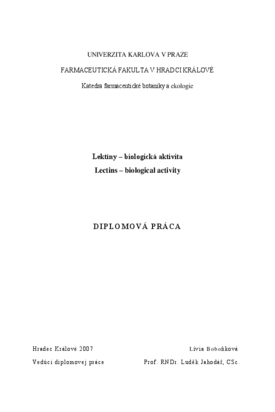Lektiny - biologická aktivita
Lectins-biological activity
diplomová práce (OBHÁJENO)

Zobrazit/
Trvalý odkaz
http://hdl.handle.net/20.500.11956/10694Identifikátory
SIS: 17762
Kolekce
- Kvalifikační práce [6566]
Autor
Vedoucí práce
Oponent práce
Spilková, Jiřina
Fakulta / součást
Farmaceutická fakulta v Hradci Králové
Obor
Farmacie
Katedra / ústav / klinika
Katedra farmaceutické botaniky a ekologie
Datum obhajoby
4. 6. 2007
Nakladatel
Univerzita Karlova, Farmaceutická fakulta v Hradci KrálovéJazyk
Čeština
Známka
Výborně
Lívia Boboňková: Lektíny-biologická aktivita, Diplomová práca, Univerzita Karlova, 2007 Lektíny viažu mono- a oligosacharidy revezibilne a s vysokou špecifitou, ale nevykazujú katalytickú aktivitu. Na rozdiel od protilátok nie sú produktom imunitnej reakcie organizmu. Každá molekula lektínu obsahuje typicky dve alebo viac väzbových miest pre monosacharidy, lektíny sú teda di- alebo polyvalentné. Nielenže viažu sacharidy na povrchu buniek, ale taktiež medzi nimi tvoria skrížené väzby. Lektíny majú schopnosť aglutinovať erytrocyty a precipitovať polysacharidy. Oba deje sú inhibované sacharidmi pre ktoré sú dané lektíny špecifické. V živočíšnej ríši majú lektíny bohaté zastúpenie, od vírusov cez baktérie až po rastliny a živočíchy. Z rastlinných lektínov je najpodrobnejšie študovaná a tiež najviac zastúpená čeľaď bôbovitých (Fabaceae), v ktorej bolo popísaných viac než 100 lektínov, prevažne izolovaných zo semien rastlín. Napriek značnému rozšíreniu rastlinných lektínov je ich skutočná fyziologická úloha nejasná. Niektoré sú výrazne toxické, obzvlášť proteíny inaktivujúce ribozómy, typ II (RIPs II). Patrí sem abrín, ricín, viskumín, modeksín a volkensín. Lektíny majú široké využitie vo výskume, najmä pri detekcii, identifikácii, či výskume fyziologických úloh sacharidov. V porovnaní s rozsiahlym...
Lívia Boboňková: Lectins-biological activity, Diploma Thesis, Charles University, 2007 Lectins bind mono- and oligosaccharides reversibly and with high specifity, but are devoid of catalytic activity, and in contrast to antibodies, are not products of immune response. Each lectin molecule contains typically two or more carbohydrate-combining sites, lectins are di- or polyvalent. Therefore, when they react with cells, for example erythrocytes, they will not only combine with the sugars on their surfaces, but will also cause cross-linking of the cells. Lectins agglutinate erythrocytes and precipitate polysaccharides. Both reactions are inhibited by the sugar ligands for which the lectins are specific. Lectins can be found in all kingdoms of life ranging from viruses through bacteria and plants to animals. The largest and most thoroughly studied family of the simple lectins is that of Fabaceae, of which close to 100 members have been characterized, almost all isolated from seeds of the plants. Despite their abundance in plants, their true physiological functions are not clearly defined. Some of them are highly toxic, especially type II ribosome inactivating proteins (RIPs II). Abrin, ricin, viscumin, modeccin and volkensin belong to this group. Lectins are widely employed in research for diverse...
